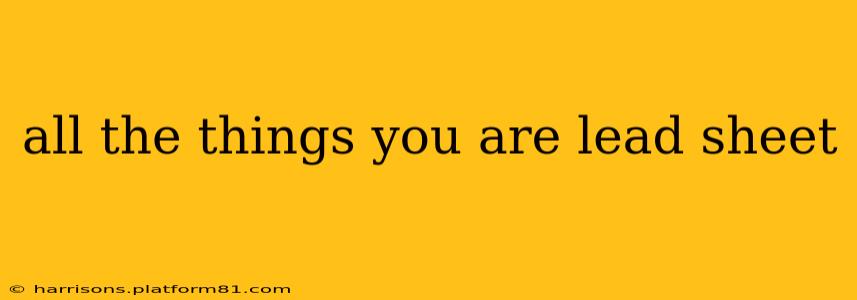All the Things You Are: A Lead Sheet Deep Dive
"All the Things You Are" is a jazz standard beloved for its sophisticated harmony and lyrical melody. Its enduring popularity stems from its adaptability – suitable for intimate settings or full big band arrangements. This lead sheet deep dive explores the song's structure, harmonic complexities, and improvisational possibilities. We'll also address some frequently asked questions surrounding this iconic tune.
Understanding the Song Structure
"All the Things You Are" follows a classic AABA song form. This means:
- A Section: This section is repeated twice, establishing the main melodic and harmonic ideas.
- B Section: This contrasting section offers a shift in harmony and melody, providing a sense of variation.
- A Section: The song concludes by returning to the familiar A section, offering a sense of resolution and closure.
Each section is further divided into phrases, typically four bars long, allowing for a natural rhythmic flow and phrasing during performance.
Harmonic Analysis: Delving into the Sophistication
The true beauty of "All the Things You Are" lies in its rich harmonic vocabulary. The song utilizes sophisticated chord progressions, moving beyond simple major and minor chords to incorporate:
- Secondary Dominants: These chords create a sense of anticipation and chromatic movement, adding harmonic interest and leading smoothly to the target chords.
- Altered Dominants: These chords add a bluesy, sophisticated feel, opening up possibilities for improvisation and colorful voicings.
- Modal Interchange: This technique involves borrowing chords from parallel modes (e.g., borrowing chords from the parallel minor key in a major key context), enriching the harmonic palette.
Improvisational Opportunities: A Playground for Musicians
The harmonic richness of "All the Things You Are" makes it an ideal vehicle for improvisation. Each chord offers a wealth of possibilities for melodic and rhythmic exploration. Musicians can:
- Target specific chord tones: Focusing on the root, third, fifth, and seventh of each chord provides a strong foundation for melodic ideas.
- Explore passing tones and neighbor tones: These embellishments add color and melodic interest.
- Utilize chromatic approaches: Approaching chord tones from chromatic neighboring notes creates a more sophisticated sound.
- Experiment with different rhythmic patterns: Varying rhythmic figures adds dynamic energy to the improvisation.
Frequently Asked Questions (FAQs)
What key is "All the Things You Are" usually played in?
While it can be transposed to various keys, "All the Things You Are" is frequently played in C minor or Eb Major. These keys offer a good balance between accessibility and harmonic complexity.
Who wrote "All the Things You Are"?
The song was composed by Jerome Kern (music) and Oscar Hammerstein II (lyrics).
What makes "All the Things You Are" a jazz standard?
Its sophisticated harmony, memorable melody, and adaptable structure have cemented its place as a jazz standard, allowing for countless interpretations and improvisations by musicians across generations.
Is it difficult to play "All the Things You Are"?
The difficulty level depends on the musician's skill and the arrangement. The melody is relatively accessible, but the harmonic complexity can present challenges for less experienced players.
Where can I find a lead sheet for "All the Things You Are"?
Numerous resources online offer lead sheets for "All the Things You Are." A simple web search will yield a variety of options, ranging from simplified versions to more complex transcriptions.
Conclusion
"All the Things You Are" stands as a testament to the enduring power of sophisticated songwriting. Its harmonic depth and melodic beauty continue to inspire musicians and listeners alike. Whether you're a seasoned jazz performer or a beginner exploring the world of jazz standards, this song offers a rewarding journey into the heart of jazz harmony and improvisation.
